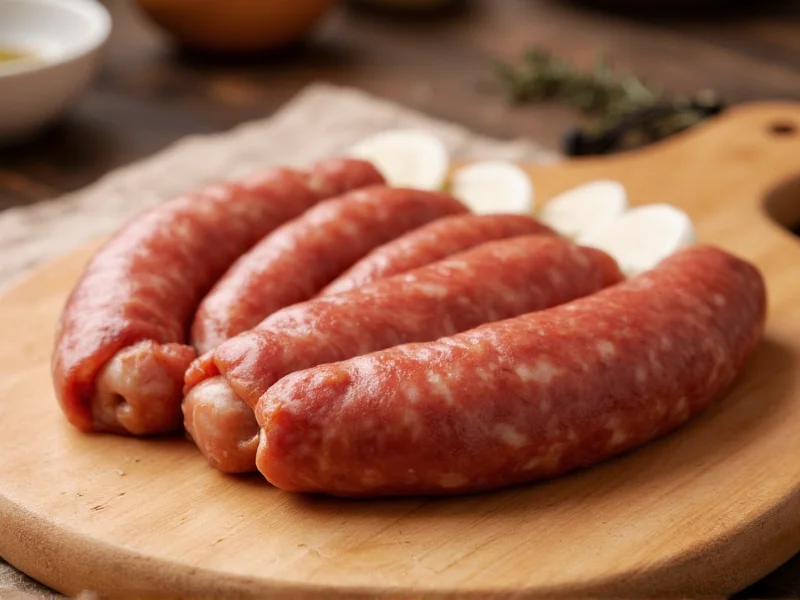Understanding sausage casing composition reveals fascinating food science behind one of the world's oldest food preservation techniques. Whether you're a home cook experimenting with charcuterie or simply curious about your breakfast links, knowing what encases your sausage provides valuable insight into food history, manufacturing processes, and dietary considerations.
Natural Casings: The Traditional Choice
Natural casings represent the original sausage packaging method dating back centuries. These edible tubes come from the submucosal layers of animal intestines, primarily from pigs, sheep, and cattle. Butchers clean and process these intestines through thorough washing, scraping, and salting to create the familiar sausage skins.
Pork casings (typically 32-35mm diameter) work best for bratwurst and fresh sausages. Sheep casings (18-24mm) provide that delicate snap perfect for breakfast links and hot dogs. Beef casings (35-40mm) suit larger sausages like salami and bologna. Each natural casing type offers unique texture and cooking properties that influence the final product's mouthfeel and appearance.
Collagen Casings: Modern Animal-Derived Alternative
Collagen casings revolutionized commercial sausage production in the mid-20th century. Manufacturers extract collagen from cattle hides through hydrolysis, then reform it into edible tubes. These casings provide consistent diameter, strength, and cooking performance that natural casings can't match at scale.
Available in both edible and inedible varieties, collagen casings dominate hot dog production. Edible collagen works for fresh sausages, while inedible versions (typically larger diameters) get removed after cooking processes like smoking. The manufacturing process creates remarkably uniform casings that maintain shape during stuffing and cooking.
Cellulose and Synthetic Casings
Cellulose casings, made from plant fibers (usually cotton linters or wood pulp), offer another commercial solution. These non-edible casings provide exceptional strength for high-speed processing and smoking. Producers remove cellulose casings after cooking, leaving the sausage with its characteristic smooth surface.
Synthetic casings made from polymers like nylon or polyester serve specialized purposes. These inedible casings withstand extreme processing conditions for products like summer sausage and large-diameter cooked hams. Their durability makes them ideal for products requiring long cooking times or complex processing.
| Casing Type | Material Source | Edibility | Common Uses | Diameter Range |
|---|---|---|---|---|
| Natural | Animal intestines | Fully edible | Traditional sausages, artisanal products | 18-40mm |
| Collagen | Animal hides | Edible or inedible varieties | Hot dogs, fresh sausages, pepperoni | 15-100mm |
| Cellulose | Plant fibers | Non-edible | Frankfurters, smoked sausages | 18-70mm |
| Synthetic | Polymer materials | Non-edible | Large cooked sausages, hams | 50-200mm |
Specialized and Emerging Casing Technologies
Food scientists continue developing innovative casing solutions. Fibrous casings combine cellulose with paper reinforcement for large-diameter products like salami and bologna. These provide structural support during long curing processes while allowing smoke penetration.
Plant-based alternatives are gaining traction as vegetarian and vegan sausage options expand. Some manufacturers use alginate (from seaweed) or other plant polymers to create edible casings suitable for meat alternatives. While these don't replicate the traditional casing experience perfectly, they serve important dietary needs.
How Casing Choice Affects Your Sausage Experience
The casing significantly influences your sausage eating experience beyond just containment. Natural casings provide that desirable 'snap' when biting into a quality sausage, while collagen offers more consistent texture. The casing material affects moisture retention during cooking, smoke absorption, and even flavor development.
When shopping for sausages, check ingredient labels if casing composition matters to you. Many premium products specify 'natural casings' as a quality indicator. For those with dietary restrictions, understanding casing materials helps avoid potential allergens or non-halal/kosher components.
Environmental and Practical Considerations
From sustainability perspectives, natural casings represent efficient use of animal byproducts that would otherwise go to waste. However, their variability creates challenges for large-scale production. Synthetic and cellulose casings generate more consistent products with less waste during manufacturing, though they introduce plastic elements into food production.
Home sausage makers often prefer natural casings for authenticity, despite the preparation work required. Pre-rinsed and packaged natural casings have made the process more accessible. For beginners, collagen casings offer easier handling while still providing edible convenience.
Frequently Asked Questions
Are all sausage casings edible?
No, not all sausage casings are edible. Natural casings and some collagen varieties are fully edible, while cellulose and synthetic casings must be removed before consumption. Most commercial hot dogs use edible collagen casings, whereas larger cooked sausages often use non-edible cellulose that's peeled off after processing.
What are hot dog casings typically made from?
Most commercial hot dogs use thin collagen casings derived from animal hides. These provide the characteristic 'snap' while maintaining consistency during high-volume production. Some premium hot dogs still use natural sheep casings for superior texture and cooking properties, while cheaper varieties might use cellulose casings that are removed after cooking.
Can vegetarians eat sausages with traditional casings?
Traditional sausage casings are animal-derived, making them unsuitable for vegetarians and vegans. However, many meat alternative sausages use plant-based casings made from materials like alginate (seaweed extract) or other vegetable polymers. Always check product labels carefully, as some vegetarian sausages might still use animal-based casings with plant-based fillings.
Why do some sausages have a better 'snap' than others?
The 'snap' comes primarily from the casing type and quality. Natural casings, especially sheep casings used for premium hot dogs, provide the most satisfying snap due to their elasticity and thickness. Higher quality collagen casings can mimic this effect, while cellulose and synthetic casings generally produce a smoother, less resistant bite. Proper casing preparation and sausage filling density also affect the final texture.
How do I prepare natural casings for homemade sausage?
To prepare natural casings, first rinse them thoroughly in cool water to remove excess salt. Soak in fresh water for 30-60 minutes, changing water occasionally. Slide the casing onto a sausage stuffer tube, leaving a small tail to tie off. Flush with water to check for holes and ensure smooth passage. Properly prepared casings should feel supple and slide easily during stuffing without tearing.











 浙公网安备
33010002000092号
浙公网安备
33010002000092号 浙B2-20120091-4
浙B2-20120091-4